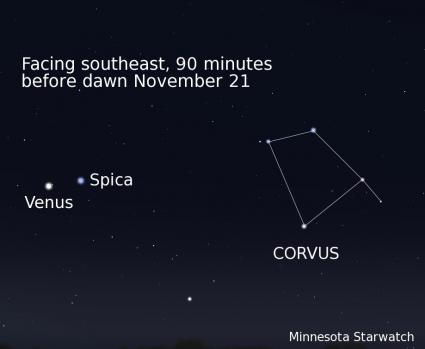Northern Sky: November 10 - 23, 2018
NORTHERN SKY – Deane Morrison
November 10 – 23, 2018
Now that we’re back on standard time, the stars come out earlier. That’s good for watching the evening sky. But the morning sun also comes up earlier than it did on daylight time. It rose over Grand Marais at 7:49 a.m. right before the switchover, and it won’t rise that late again till the second half of December. So for now, everybody will have to get out earlier to see the morning show.
The star of that show is our old friend Venus. It’s climbing over the eastern horizon as it emerges from a trip between Earth and the sun, and so it’s relatively close and very bright. It starts out as a thin crescent, and through a small telescope or even a pair of very strong and steady binoculars, you can see the crescent getting thicker as the days go by. The star above Venus is Spica, in Virgo. If you go out on only one day, try the 14th, when the planet and the star will be at their minimum distance, just over two moon widths apart. Look about an hour before sunrise.
Jupiter will join Venus next month, but right now it's in the process of falling out of the evening sky and getting lost in the sunset. And Saturn is right behind it. In both cases, Earth is going around the sun, leaving those planets behind. In the east, the bright winter constellations are making their annual entrance. However, only a few, like the Pleiades star cluster and Taurus, the bull, are up right after nightfall. If you’re out at that time and looking for something new, you may want to see if you can find some double stars that are up in early evening. Binoculars are highly recommended here.
The first double star is easy: it’s at the bend of the Big Dipper's handle. The Big Dipper is now sitting pretty much upright, just above the northern horizon. The double star in the handle is well known, and you can see it without binoculars if your vision is good. While you’re there, you can use the Big Dipper to find Polaris, the north star. The two stars on the bowl of the Big Dipper that are farthest from the handle point toward the north star. Also, try to find the whole Little Dipper. Polaris is at the free end of its handle, and keep in mind that the two "bowl" stars nearest the handle are pretty dim. The second double star is in Taurus. To recap, it's in the east after nightfall. Find the face of the bull, with a star chart if you need one. You'll see the bright star Aldebaran next to the Hyades star cluster, which is shaped like a V. Follow the line of stars from Aldebaran toward the point of the V, and you'll see the double star. Binoculars will help. Use them again on the Pleiades, which appear to the naked eye as a fuzzy patch above Aldebaran. The third double star is the most challenging. Find Vega, a brilliant star in the west, and look just above it for a tight doublet of stars. You’ll definitely need binoculars for that one. And you may want to postpone your search for double stars until after full moon because a waxing or full moon can wash out the dimmer stars in the early-evening sky.
Our full moon arrives at 11:39 p.m. on the 22nd, which is Thanksgiving Day. It rises over Grand Marais at 4:28 that afternoon, and for my money, that's when it will be most beautiful. At nightfall, it will be between and just west of Aldebaran and the Hyades, below, and the Pleiades above.
Tweet




